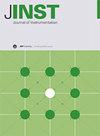Measurement of the electron beam profile by the multiangle scanning method
IF 1.3
4区 工程技术
Q3 INSTRUMENTS & INSTRUMENTATION
引用次数: 0
Abstract
Nowadays, ionizing radiation beams with relatively large transverse dimensions are widely used not only for research purposes but also in technological processes related to metal and food treatment, as well as medical instrument sterilization. Thus, control of beam characteristics is required, and in particular, the intensity distribution in the transverse plane must be accurately measured. The multiangle scanning method, based on mathematical transformations, allows overcoming the limitations of modern detectors used for these purposes. In this study, the method was applied to an electron beam. A detection system based on scintillating fiber was used. The beam profile was measured using the proposed method and a conventional detector — a film dosimeter. Experimental results allow to conclude that the beam intensity distribution obtained using the multiangle scanning method is close to the results obtained using a film dosimeter, which is most often used in medical institutions. Thus, we can consider the multiangle scanning method as an effective approach for determining the intensity distribution of an electron beam.多角度扫描法测量电子束轮廓
如今,横向尺寸相对较大的电离辐射束不仅广泛用于研究目的,而且还用于与金属和食品处理以及医疗器械消毒相关的技术过程。因此,需要对光束特性进行控制,特别是必须精确测量横向平面上的强度分布。基于数学变换的多角度扫描方法可以克服用于这些目的的现代探测器的局限性。在这项研究中,该方法被应用于电子束。使用了基于闪烁光纤的检测系统。使用提出的方法和传统探测器(薄膜剂量计)测量了电子束轮廓。实验结果表明,使用多角度扫描方法得到的光束强度分布与使用胶片剂量计得到的结果接近,而胶片剂量计在医疗机构中最常用。因此,我们可以认为多角度扫描法是确定电子束强度分布的有效方法。
本文章由计算机程序翻译,如有差异,请以英文原文为准。
求助全文
约1分钟内获得全文
求助全文
来源期刊

Journal of Instrumentation
工程技术-仪器仪表
CiteScore
2.40
自引率
15.40%
发文量
827
审稿时长
7.5 months
期刊介绍:
Journal of Instrumentation (JINST) covers major areas related to concepts and instrumentation in detector physics, accelerator science and associated experimental methods and techniques, theory, modelling and simulations. The main subject areas include.
-Accelerators: concepts, modelling, simulations and sources-
Instrumentation and hardware for accelerators: particles, synchrotron radiation, neutrons-
Detector physics: concepts, processes, methods, modelling and simulations-
Detectors, apparatus and methods for particle, astroparticle, nuclear, atomic, and molecular physics-
Instrumentation and methods for plasma research-
Methods and apparatus for astronomy and astrophysics-
Detectors, methods and apparatus for biomedical applications, life sciences and material research-
Instrumentation and techniques for medical imaging, diagnostics and therapy-
Instrumentation and techniques for dosimetry, monitoring and radiation damage-
Detectors, instrumentation and methods for non-destructive tests (NDT)-
Detector readout concepts, electronics and data acquisition methods-
Algorithms, software and data reduction methods-
Materials and associated technologies, etc.-
Engineering and technical issues.
JINST also includes a section dedicated to technical reports and instrumentation theses.
 求助内容:
求助内容: 应助结果提醒方式:
应助结果提醒方式:


